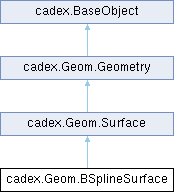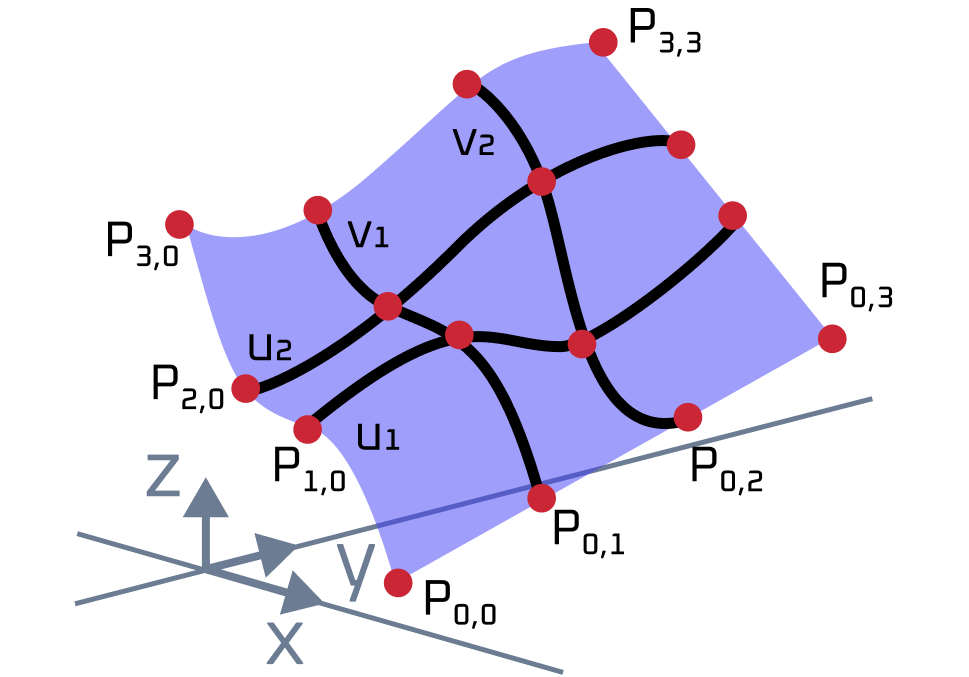Defines a B-Spline surface. More...

Public Member Functions | |
| BSplineSurface (global::System.IntPtr cPtr, bool cMemoryOwn) | |
| BSplineSurface (cadex.Collections.PointList thePoles, int theNumberOfUPoles, int theNumberOfVPoles, cadex.Collections.DoubleList theUKnots, cadex.Collections.DoubleList theVKnots, cadex.Collections.IntList theUMults, cadex.Collections.IntList theVMults, int theUDegree, int theVDegree, bool theIsUPeriodic, bool theIsVPeriodic) | |
| Constructor. | |
| BSplineSurface (cadex.Collections.PointList thePoles, int theNumberOfUPoles, int theNumberOfVPoles, cadex.Collections.DoubleList theUKnots, cadex.Collections.DoubleList theVKnots, cadex.Collections.IntList theUMults, cadex.Collections.IntList theVMults, int theUDegree, int theVDegree, bool theIsUPeriodic) | |
| BSplineSurface (cadex.Collections.PointList thePoles, int theNumberOfUPoles, int theNumberOfVPoles, cadex.Collections.DoubleList theUKnots, cadex.Collections.DoubleList theVKnots, cadex.Collections.IntList theUMults, cadex.Collections.IntList theVMults, int theUDegree, int theVDegree) | |
| BSplineSurface (cadex.Collections.PointList thePoles, cadex.Collections.DoubleList theWeights, int theNumberOfUPoles, int theNumberOfVPoles, cadex.Collections.DoubleList theUKnots, cadex.Collections.DoubleList theVKnots, cadex.Collections.IntList theUMults, cadex.Collections.IntList theVMults, int theUDegree, int theVDegree, bool theIsUPeriodic, bool theIsVPeriodic) | |
| Constructor. | |
| BSplineSurface (cadex.Collections.PointList thePoles, cadex.Collections.DoubleList theWeights, int theNumberOfUPoles, int theNumberOfVPoles, cadex.Collections.DoubleList theUKnots, cadex.Collections.DoubleList theVKnots, cadex.Collections.IntList theUMults, cadex.Collections.IntList theVMults, int theUDegree, int theVDegree, bool theIsUPeriodic) | |
| BSplineSurface (cadex.Collections.PointList thePoles, cadex.Collections.DoubleList theWeights, int theNumberOfUPoles, int theNumberOfVPoles, cadex.Collections.DoubleList theUKnots, cadex.Collections.DoubleList theVKnots, cadex.Collections.IntList theUMults, cadex.Collections.IntList theVMults, int theUDegree, int theVDegree) | |
| int | UDegree () |
| Returns U-degree. | |
| int | VDegree () |
| Returns V-degree. | |
| int | NumberOfUPoles () |
| Returns number of U-poles. | |
| int | NumberOfVPoles () |
| Returns number of V-poles. | |
| int | NumberOfUKnots () |
| Returns number of unique U-knots. | |
| int | NumberOfVKnots () |
| Returns number of unique V-knots. | |
| cadex.Geom.Point | Pole (int theUIndex, int theVIndex) |
| Returns a pole value. | |
| cadex.Collections.PointList | Poles () |
| Populates a 2D table of poles. | |
| double | Weight (int theUIndex, int theVIndex) |
| Returns a weight value. | |
| cadex.Collections.DoubleList | Weights () |
| Populates a 2D table of weights. | |
| double | UKnot (int theUIndex) |
| Returns a U-knot value. | |
| double | VKnot (int theVIndex) |
| Returns a V-knot value. | |
| cadex.Collections.DoubleList | UKnots () |
| Populates a vector of U-knots. | |
| cadex.Collections.DoubleList | VKnots () |
| Populates a vector of V-knots. | |
| int | UMultiplicity (int theUIndex) |
| Returns a U knot multiplicity. | |
| int | VMultiplicity (int theVIndex) |
| Returns a V knot multiplicity. | |
| cadex.Collections.IntList | UMultiplicities () |
| Populates a vector of U knot multiplicities. | |
| cadex.Collections.IntList | VMultiplicities () |
| Populates a vector of V knot multiplicities. | |
| bool | IsURational () |
| Returns true if the B-Spline curve is rational in U direction. | |
| bool | IsVRational () |
| Returns true if the B-Spline curve is rational in V direction. | |
 Public Member Functions inherited from cadex.Geom.Surface Public Member Functions inherited from cadex.Geom.Surface | |
| Surface (global::System.IntPtr cPtr, bool cMemoryOwn) | |
| cadex.Geom.SurfaceType | Type () |
| Returns a surface type. | |
| cadex.Geom.Continuity | Continuity () |
| Returns a continuity type of the surface. | |
| cadex.Geom.Point | Value (double theParameterU, double theParameterV) |
| Evaluates a point on the surface. | |
| cadex.Geom.Direction | Normal (double theParameterU, double theParameterV) |
| bool | IsUPeriodic () |
| Returns true if the surface is periodic in U direction. | |
| bool | IsVPeriodic () |
| Returns true if the surface is periodic in V direction. | |
| double | UMin () |
| Returns a minimum parameter of a definition domain in U direction. | |
| double | UMax () |
| Returns a maximum parameter of a definition domain in U direction. | |
| double | VMin () |
| Returns a minimum parameter of a definition domain in V direction. | |
| double | VMax () |
| Returns a maximum parameter of a definition domain in V direction. | |
| void | Domain (out double theUMin, out double theUMax, out double theVMin, out double theVMax) |
| Returns a definition domain. | |
| bool | IsTrimmed () |
| Returns whether surface is trimmed or not. | |
| void | SetTrim (double theUFirst, double theULast, double theVFirst, double theVLast) |
| Trims surface with [theUFirst, theULast] x [theVFirst, theVLast] section. | |
| void | Transform (cadex.Geom.Transformation theTransformation) |
| Applies transformation matrix to this object. | |
| cadex.Geom.Surface | Transformed (cadex.Geom.Transformation theTransformation) |
| Returns a copy this object after applying transformation. | |
| void | D0 (double theParameterU, double theParameterV, cadex.Geom.Point theValue) |
| void | D1 (double theParameterU, double theParameterV, cadex.Geom.Point theValue, cadex.Geom.Vector theD1U, cadex.Geom.Vector theD1V) |
| void | D2 (double theParameterU, double theParameterV, cadex.Geom.Point theValue, cadex.Geom.Vector theD1U, cadex.Geom.Vector theD1V, cadex.Geom.Vector theD2U, cadex.Geom.Vector theD2V, cadex.Geom.Vector theD2UV) |
| bool | DN (double theParameterU, double theParameterV, uint theDerivativeOrder, cadex.Geom.Point theValue, cadex.Collections.VectorList theD) |
| void | Curvature (double theParameterU, double theParameterV, cadex.Geom.Direction thePrincipalMaxDirection, cadex.Geom.Direction thePrincipalMinDirection) |
| void | Curvature (double theParameterU, double theParameterV, cadex.Geom.Direction thePrincipalMaxDirection, cadex.Geom.Direction thePrincipalMinDirection, out double theMaxCurvature, out double theMinCurvature) |
| void | Mirror (cadex.Geom.Point thePoint) |
| void | Mirror (cadex.Geom.Axis1d theAxis) |
| void | Mirror (cadex.Geom.Axis3d theAxis) |
| cadex.Geom.Surface | Mirrored (cadex.Geom.Point theRef) |
| cadex.Geom.Surface | Mirrored (cadex.Geom.Axis1d theAxis) |
| cadex.Geom.Surface | Mirrored (cadex.Geom.Axis3d theAxis) |
| void | Rotate (cadex.Geom.Axis1d theAxis, double theAngle) |
| cadex.Geom.Surface | Rotated (cadex.Geom.Axis1d theAxis, double theAngle) |
| void | Translate (cadex.Geom.Vector theVector) |
| cadex.Geom.Surface | Translated (cadex.Geom.Vector theVector) |
| void | Scale (cadex.Geom.Point thePoint, double theScale) |
| cadex.Geom.Surface | Scaled (cadex.Geom.Point thePoint, double theScale) |
 Public Member Functions inherited from cadex.Geom.Geometry Public Member Functions inherited from cadex.Geom.Geometry | |
| Geometry (global::System.IntPtr cPtr, bool cMemoryOwn) | |
 Public Member Functions inherited from cadex.BaseObject Public Member Functions inherited from cadex.BaseObject | |
| BaseObject (global::System.IntPtr cPtr, bool cMemoryOwn) | |
| void | Dispose () |
| bool | IsNull () |
| ulong | Id () |
| Return unique identifier of public object. | |
| bool | IsEqual (cadex.BaseObject theObj) |
| override int | GetHashCode () |
| override bool | Equals (System.Object o) |
Static Public Member Functions | |
| static new bool | CompareType (cadex.BaseObject theObject) |
| static cadex.Geom.BSplineSurface | Cast (cadex.Geom.Surface theBase) |
 Static Public Member Functions inherited from cadex.Geom.Surface Static Public Member Functions inherited from cadex.Geom.Surface | |
| static new bool | CompareType (cadex.BaseObject theObject) |
 Static Public Member Functions inherited from cadex.Geom.Geometry Static Public Member Functions inherited from cadex.Geom.Geometry | |
| static bool | CompareType (cadex.BaseObject theObject) |
| static cadex.Geom.Geometry | Cast (cadex.BaseObject theBase) |
Protected Member Functions | |
| override void | Dispose (bool disposing) |
 Protected Member Functions inherited from cadex.Geom.Surface Protected Member Functions inherited from cadex.Geom.Surface | |
| override void | Dispose (bool disposing) |
Defines a B-Spline surface.
B-Spline surface is defined by degree, control points (poles), their weights, unique knots and their multiplicities. The following image depicts an example of a B-Spline surface:

For introduction to and mathematical definition of NURBS please refer to external resources, for instance:
A rational B-Spline contains an explicit vector of weights, whereas polynomial does not.
The number of poles must equal the number of weights. The number of poles in each direction (U or V) is defined via the following formulas:
B-Splines of degree up to 25 are supported.
|
inline |
Constructor.
Creates a polynomial B-Spline surface.
Parameters:
Number of poles in U and V direction must meet the requirements described above.
|
inline |
Constructor.
Creates a rational B-Spline surface.
Parameters:
Number of poles in U and V direction must meet the requirements described above.
Poles are to be provided after division by their weights.
|
inlineprotectedvirtual |
Reimplemented from cadex.BaseObject.
|
inline |
Returns true if the B-Spline curve is rational in U direction.
|
inline |
Returns true if the B-Spline curve is rational in V direction.
|
inline |
Returns number of unique U-knots.
Returns the value specified in the constructor.
|
inline |
Returns number of U-poles.
Returns the value specified in the constructor.
|
inline |
Returns number of unique V-knots.
Returns the value specified in the constructor.
|
inline |
Returns number of V-poles.
Returns the value specified in the constructor.
|
inline |
Returns a pole value.
theUIndex must be in the range [1, NumberOfUPoles()], theVIndex in the range [1, NumberOfVPoles()].
|
inline |
Populates a 2D table of poles.
thePoles must point to a buffer in memory with at least NumberOfUPoles() * NumberOfVPoles() preallocated values.
Returns NumberOfUPoles() * NumberOfVPoles().
|
inline |
Returns U-degree.
Returns the value specified in the constructor.
|
inline |
Returns a U-knot value.
theIndex must be in the range [1, NumberOfUKnots()].
|
inline |
Populates a vector of U-knots.
theUKnots must point to a buffer in memory with at least NumberOfUKnots() preallocated values.
Returns NumberOfUKnots().
|
inline |
Populates a vector of U knot multiplicities.
theUMults must point to a buffer in memory with at least NumberOfUKnots() preallocated values.
Returns NumberOfUKnots().
|
inline |
Returns a U knot multiplicity.
theIndex must be in the range [1, NumberOfUKnots()].
|
inline |
Returns V-degree.
Returns the value specified in the constructor.
|
inline |
Returns a V-knot value.
theIndex must be in the range [1, NumberOfVKnots()].
|
inline |
Populates a vector of V-knots.
theVKnots must point to a buffer in memory with at least NumberOfVKnots() preallocated values.
Returns NumberOfVKnots().
|
inline |
Populates a vector of V knot multiplicities.
theVMults must point to a buffer in memory with at least NumberOfVKnots() preallocated values.
Returns NumberOfVKnots().
|
inline |
Returns a V knot multiplicity.
theIndex must be in the range [1, NumberOfVKnots()].
|
inline |
Returns a weight value.
theUIndex must be in the range [1, NumberOfUPoles()], theVIndex in the range [1, NumberOfVPoles()].
For polynomial B-Spline behavior is undefined.
|
inline |
Populates a 2D table of weights.
theWeights must point to a buffer in memory with at least NumberOfUPoles() * NumberOfVPoles() preallocated values.
Returns NumberOfUPoles() * NumberOfVPoles().
For polynomial B-Spline does nothing and returns 0.